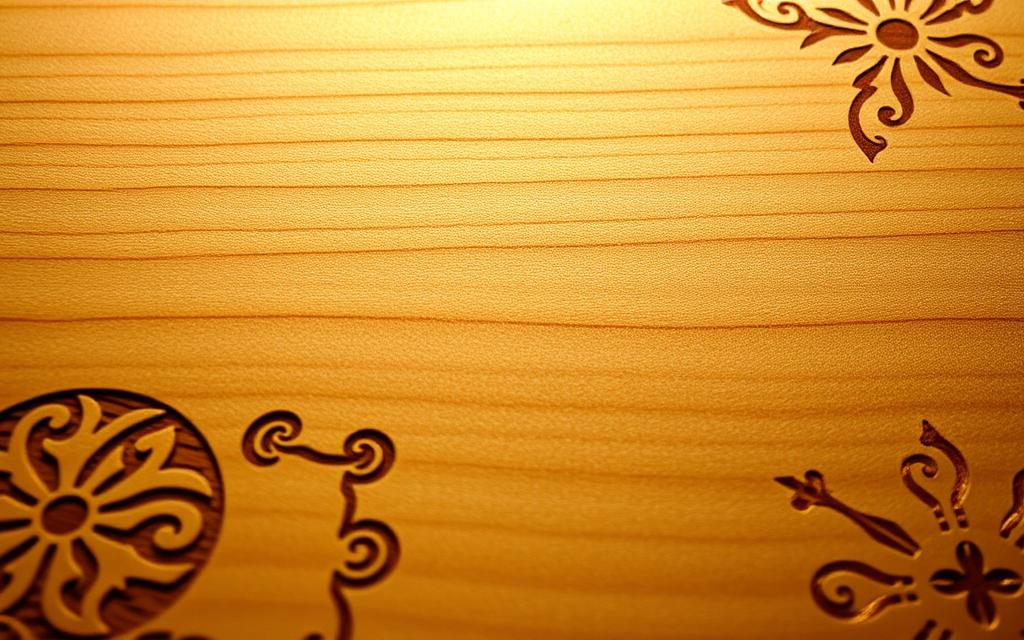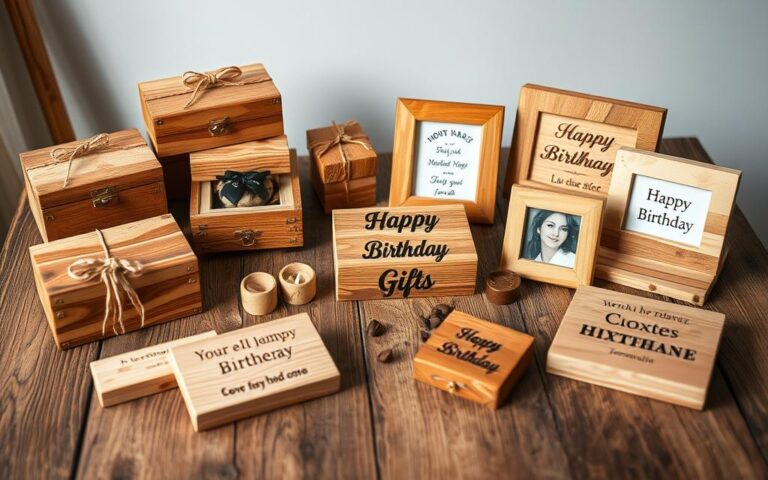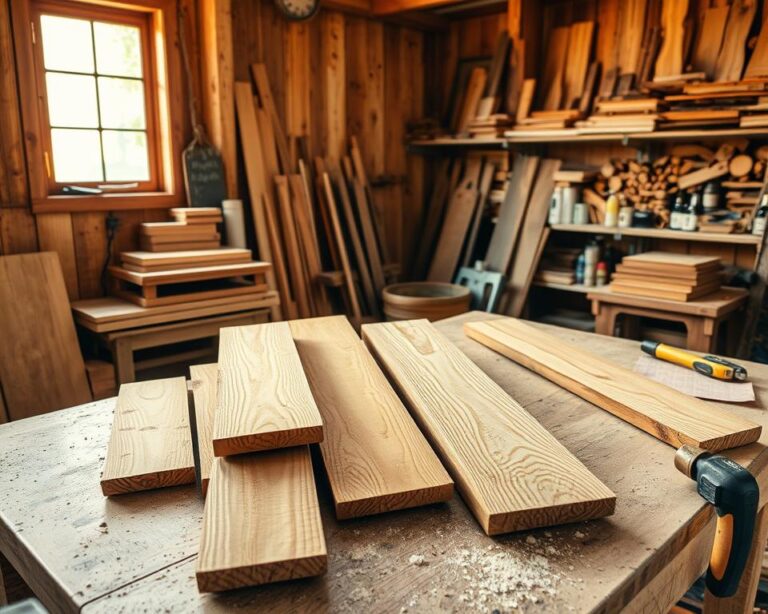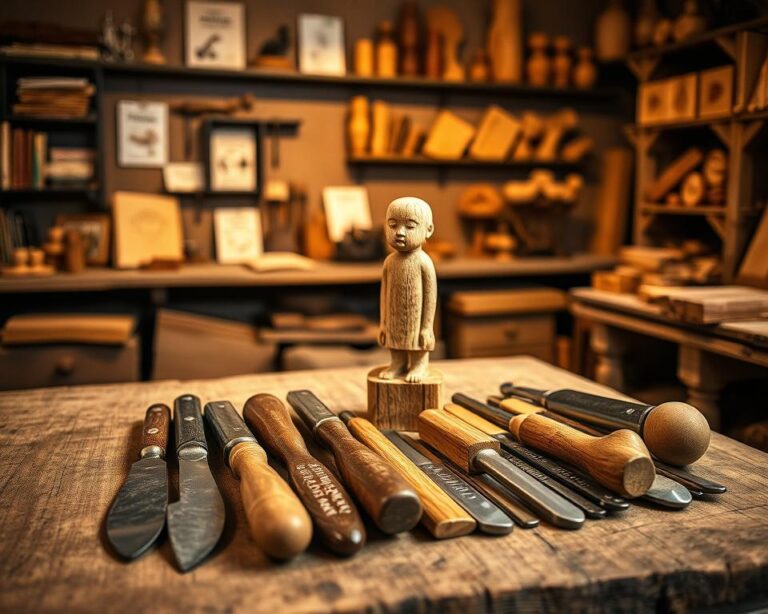Do you know the laser engraving market might pass $6 billion by 2025? This growth shows how much people want custom wood engravings for work and fun. It’s not just for looks. This method uses intense lasers to turn simple wood into beautiful artwork and unique gifts. With these lasers, you can make detailed designs. This makes laser-engraved wood a top pick for hobbyists and pros.
Today, we’re going to dive into the must-have tools, techniques, and cool project ideas for laser engraving. If you’re into making personalized gifts, decorating your home, or creating functional items, you’ll learn what it takes to make your projects pop.
Introduction to Laser Engraving on Wood
Laser engraving is a cutting-edge method that boosts creativity and accuracy in woodworking. It uses a focused laser to mark designs on wood surfaces. The technique achieves amazing details by vaporizing the wood’s top layer for art and industry uses.
What is Laser Engraving?
Laser engraving is an advanced method that uses lasers to carve designs into surfaces. It’s a flexible wood engraving technology perfect for both custom gifts and intricate wood patterns. Its high precision supports multiple textures and styles, making it popular among artisans and factories.
Brief History of Laser Technology
The history of laser engraving started in the 1960s with the debut of solid-state lasers for industrial tasks. This technology has grown, becoming cheaper and more accessible to both enthusiasts and professional woodworkers over time. Today, cutting-edge software enhances laser engraving, leading to unique woodworking and design breakthroughs.
Essential Tools for Laser Wood Engraving
Laser engraving wood can give amazing results with the right tools. It’s important to know about different types of laser engravers. This helps you pick the best one for your needs. There are many tools you’ll need to get the best out of your projects and make sure the results are top-notch.
Types of Laser Engravers
Exploring different types of laser engravers is crucial when you start. CO2 lasers are great for wood, giving fast and detailed results. Other lasers, like fiber ones, work better on harder materials but aren’t used as much for wood.
Recommended Brands and Models
Glowforge and Epilog are top names in laser engraving machines. Glowforge is great for beginners because it’s easy to use. Epilog machines are more for pros. Both brands are known for their reliability, making complex designs easy to achieve.
Additional Equipment Needed
You’ll need more than just a laser engraver. A computer with design software, safety gear like goggles, and finishing products are also important. Having the right setup boosts your experience and the quality of your final work.
Choosing the Right Type of Wood for Engraving
The type of wood you choose for engraving is very important. It can greatly affect how your final piece looks and feels. Different woods produce different results in quality and appearance. It’s key to know the difference between hardwoods and softwoods to get the best results. This knowledge helps with understanding wood grain effects and the final finish.
Hardwoods vs. Softwoods
Hardwoods, like maple and cherry, are top choices for laser engraving. They have a dense structure which leads to smooth, clear engravings. Softwoods, such as pine, are cheaper and easier to use. However, their uneven grain can make engravings less predictable.
Popular Wood Types for Laser Engraving
- Maple: Characterized by its fine grain and light color, ideal for intricate designs.
- Cherry: Offers a rich color that deepens with age, suitable for elegant engravings.
- Pine: A common choice for budget projects; however, grain variations can affect engraving quality.
- Bamboo: An eco-friendly option that provides a unique look and is easy to engrave.
- Walnut: Known for its dark hues and attractive grain patterns, great for sophisticated projects.
Considerations for Wood Grain and Finish
The grain and finish of the wood matter a lot in engraving. Smooth woods are better for clear images and details. Rougher grains can give a textured look, which might or might not be what you want. Composite materials can be more uniform, making them good for detailed work. They help ensure the wood grain effects are high quality.
Setting Up Your Work Area
Creating a good laser engraving workspace takes thoughtful planning. It’s important to make safety a top priority. This keeps the area safe and helps your creativity flow smoothly.
Safety Precautions
Start with good ventilation to handle the fumes and smoke. Having fire extinguishers close is also key for safety. Protective eyewear is a must to protect your eyes from the laser.
Keeping your workspace neat and organized also reduces risks.
Necessary Workspace Tools
Having the right tools boosts your workspace’s efficiency. Clamps keep your materials in place for detailed work. Leveling tools ensure wood is perfectly straight for precise engraving.
A good measuring tape is key for setting things up accurately.
Optimizing Lighting Conditions
Lighting is crucial in your laser engraving area. It helps you see small details and align designs correctly. Adjustable LED lights are great because they light up the space well without making it hard to see on shiny surfaces.
This makes your work area safer and more comfortable, especially when working for a long time.
| Safety Precautions | Workspace Tools | Lighting Optimization |
|---|---|---|
| Ventilation systems | Clamps | LED lights |
| Fire extinguishers | Leveling equipment | Adjustable light fixtures |
| Protective eyewear | Measuring tape | Positioning for no glare |
| Organized workspace | Cutting mats | Bright and focused lighting |
Software for Laser Engraving Projects
Picking the right software is key for great laser engraving projects. Many tools can make your designs better and more precise. Taking the time to choose the best design software will lead to amazing results.
Best Design Software Options
Adobe Illustrator and CorelDRAW are top picks for laser engraving software. They have lots of features for making detailed vector graphics, perfect for engraving. Adobe Illustrator stands out for its detailed design control. Meanwhile, CorelDRAW is great because it’s easy to use and has many tools.
File Formats for Laser Engraving
It’s important to know which file formats work best for laser engraving. SVG and AI are popular because they keep your design details sharp. Using the right format makes the engraving machine work better and makes your job easier.
Tips for Effective Design
Using good design tips can really improve your work. Make graphics simple for better clarity on small items. Use layers to manage details better, which lets you adjust things as needed. Remember these tips to make your engravings look better and to level up your skills.
Techniques for Successful Laser Engraving
To do well in laser engraving, knowing several technical parts is key. It’s vital to get the settings right, like speed and power, to achieve what you want. Since different types of wood react in their own ways, adjusting these settings is crucial for the best results.
Understanding Settings for Speed and Power
Speed and power settings greatly affect how your engraving turns out. Using lower speeds can make deeper engravings, while higher speeds result in shallower ones. The power setting controls how strong the laser beam is. It’s best for those new to this to start with middle-range settings and then tweak from there. This often leads to more precise engraving skills.
Tips for Alignment and Positioning
Getting the wood aligned right in the machine is very important. If it’s off, the design might not be where you want, wasting materials. Make sure the wood is secure and placed correctly before starting. Using guides or rulers helps with accuracy. Also, make sure the laser is focused right to get the best from your settings.
Experimenting with Different Designs
Trying different designs adds a creative touch. Playing with various shapes, words, and patterns not only builds your skills but can also bring about one-of-a-kind projects. Keeping track of what works best helps improve your techniques and grow your style. Accept that making mistakes is part of learning. These experiences are very valuable.
| Wood Type | Recommended Speed (mm/s) | Recommended Power (%) | Engraving Depth (mm) |
|---|---|---|---|
| Basswood | 300 | 60 | 1.5 |
| Pine | 350 | 70 | 2.0 |
| Cherry | 250 | 70 | 1.5 |
| Maple | 325 | 65 | 1.0 |
Popular Uses for Laser Engraved Wood
Laser engraved wood is now more popular in many fields. It makes unique, tailored items. The technique’s flexibility shows the wide uses of laser engraved wood. It attracts those wanting personalized wooden gifts and decorative wood products.
Personalized Gifts
Creating personalized wooden gifts like custom coasters and cutting boards adds a personal touch. They are perfect for weddings, anniversaries, and birthdays. Engraving messages or names makes them even more special.
Home Décor Items
The desire for unique home décor has increased laser-engraved wood signs and art’s popularity. These decorative wood products can have quotes or family names. They let owners show their style at home.
From wall art to rustic signs, wooden décor adds charm to any space.
Functional Products
Laser engraving is not just about looks. Engraved kitchen tools mix beauty with use. Also, companies use it for branded items like wooden pens. It shows their logo in a creative, professional way.
Maintenance and Care of Engraved Wood
It’s important to keep engraved wood looking good. Doing so keeps the detailed work shining. Using the right cleaning and protecting ways means your engraving stays perfect. This will make sure your wood pieces last a long time.
Cleaning Techniques
Being gentle is key when cleaning engraved wood. Use a soft, damp cloth to remove dust. Stay away from rough materials that can scratch or harm the engraving. If you need to clean more, a mild soap and water mix is good. Just make sure to dry it well to stop water damage.
Protecting Your Engravings
Putting on a clear sealant helps protect your engravings. It fights off damage from handling and water. Checking the sealant now and then is wise. It tells you if you need to put more on. Doing this keeps your engraved wood safe.
Repairing Damaged Areas
If your engraving gets damaged, sanding lightly might fix it. You might need to paint it again or apply a new finish. This helps keep your engraved piece looking great. Taking these steps is part of good care for engraved wood. It means your art stays beautiful longer.
Troubleshooting Common Engraving Issues
Troubleshooting laser engraving can be tricky, especially when you run into common problems. Knowing why these issues happen is key to high-quality projects.
Inconsistent Results
Laser engraving can be uneven for many reasons. If the speed or power is wrong, your engravings might not look right. Also, if things aren’t lined up well, your design might be off. It’s important to keep checking and tweaking your machine’s settings.
Burn Marks and Surface Damage
Burn marks are a big headache when engraving wood. They usually mean your power or speed is too high. Trying out different settings on scrap wood can help you find the best ones. This way, you avoid damage and still get the details you want.
Software and Hardware Errors
Software errors can be a big issue. This happens a lot with the wrong file types or bad designs. Make sure your design software is updated and your files are in the right format for your engraver. Hardware problems mean something might be wrong with the engraver. You’ll need to check it well for any mechanical issues that could affect how it works.

Conclusion and Future Trends in Laser Engraving
The future of laser engraving on wood is very promising. Innovations like higher wattage lasers and better software make engravings sharper and quicker. These advancements help engravers create more detailed designs easily. This is great news for both hobbyists and pros.
People are now looking for items that are personalized and tailored just for them. This trend shows they want unique things that show off their style. With new tech, companies can meet these needs better. This makes laser engraved items even more appealing.
The laser engraving field is about to change a lot. New technologies and the demand for one-of-a-kind wooden items bring new opportunities. We are on the brink of seeing amazing changes. These will push creativity to new heights in this craft.




